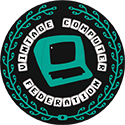Skip to content
- In the 1870s, a slide rule company called Keuffel & Esser was the Microsoft of its day. They were based in Hoboken.
- In the 1920s, programmer-to-be Grace Hopper graduated from the Wardlaw-Hartridge high school in Plainfield. Hopper later led the team that developed COBOL and went on to become an admiral in the U.S. Navy.
- Early work on ENIAC, the world’s first general-purpose electronic computer, was done at the University of Pennsylvania — however its co-inventor John Mauchly (1977 Trenton Computer Festival lecture, VCF East 5.0 lecture – Bill Mauchly) told Smithsonian historians that he was “impelled” to build it after experiencing mathematical challenges for radar antennas at New Jersey’s Camp Evans (a Fort Monmouth outpost which is now the InfoAge Science Center, housing various science museums including ours!).
- Also at Camp Evans, engineers from 1943-1945 joined the National Defense Research Committee’s Vacuum Tube Development Committee, pushing for commercial applications of the technology.
- From 1945-1951, mathematician John von Neumann helped build an early computer at the Institute for Advanced Study in Princeton. Its design came to be known as “von Neumann architecture”, however, von Neumann heavily based his work on the ENIAC plan.
- Up the road at Bell Labs, in Murray Hill, the calendar year 1948 saw the invention of the transistor, cellular networks, and Claude Shannon’s seminal paper on information theory — imagine where we’d be today with that magical year! Bell Labs also worked on early electromechanical computers and transistor computers (VCF East 7.0 lecture).
- When the time came for Bell Labs to demonstrate the transistor to the nation’s top scientists, Camp Evans chief engineer Harold Zahl led the charge to keep the technology public, not secret.
- Over at Camp Evans, engineers in 1953 demonstrated cathode ray tube technology to teams from IBM and MIT. Those teams then collaborated on Whirlwind II, which became SAGE — Semi-Automatic Ground Environment — an early-warning system for missile attacks. SAGE was the first computer using CRT output.
- More developments from Camp Evans: in 1956 they built a computer called MOBIDIC in two 30-foot trailers. “MOBile DIgital Computer” was perhaps the first mobile computer that was more than just a one-time prototype (VCF East 5.0 lecture). They also made Fieldata, which was the basis for ASCII. Your modern computer, tablet, and smartphone still use ASCII today.
- Next up at Camp Evans, IBM visited to host its first Scientific Computing Seminar, which merged into the nascent SHARE — a mainframe user group advocating what’s now known as open-source software.
- Camp Evans staff were busy! In 1957 they were a primary testing facility for Micro-Module, an Army/RCA project for solid-state electronics miniaturization.
- RCA, in Camden and Somerville, was a leader in business computing in the 1950s-1960s (VCF East 6.0 lecture).
- Monmouth County-based Electronic Associates Inc. (EAI) was a world leader in analog computing from the 1950s-1970s.
- Bell Labs kept ups its own innovations. Their staff developed MOSFET transistors around 1959-1960, the UNIX operating system in 1969 (which eventually became the root of all modern Apple, Chrome, and Linux software), and the C programming language in 1972.
- High school computer clubs were very rare in the 1960s-1970s. One of them was the RESISTORS (“Radically Emphatic Students Interested in Science, Technology, and Other Research Subjects”) usually associated with Western Electric/Bell Labs engineer Claude Kagan (VCF East 5.0 lecture) of the Mercer County area. In his barn, Claude taught students to operate a Burroughs B-205 vacuum tube computer (photo) and DEC PDP-8 minicomputer (photos) — the latter is now restored into working condition (restoration ceremony video) and on display in our museum. RESISTORS routinely impressed adult computer professionals at industry conferences.
- David Ahl, a DEC education specialist, formed the hobby magazine Creative Computing in 1974 from his home in Morristown.
- Silicon Valley’s Homebrew Computer Club is legendary, but there were clubs just like it all over. A club formed in Scotch Plains and still meets there today — the Amateur Computer Group of New Jersey (ACGNJ).
- In 1976, New Jersey hosted the first two national computer shows for the general public — these were the Trenton Computer Festival (which still exists) and the (Atlantic City) Personal Computing Conference. At the latter, a tiny start-up called Apple made its public debut.
- Many microcomputer companies called New Jersey their home in the 1980s. These included Casio, Epson, Franklin, Panasonic, RCA, Sharp, Sony, and Technical Design Labs.
- In the 2000s, Vonage became one of the first companies to offer telephone service via the Internet. Today, almost all telephone service includes data transmitted over the Internet.
- In addition to the VCF/Mid-Atlantic museum, there are several other important computer history entities in New Jersey today, including the IEEE History Center (Stevens Institute of Technology), The College of New Jersey’s Sarnoff Collection, Rolenta Press, and several retro-themed videogame arcades.
